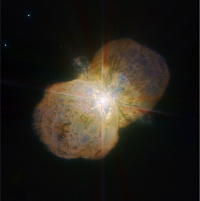Difference between revisions of "Triggers:LBVs"
From Gaia Science Alerts Working Group
Jump to navigationJump to search (Created page with 'Known also as S Dor stars. Exhibit slow changes in brightness with occasional outbursts of substantial mass loss. Known example: Eta Carinae. [[File:ESO-Eta_Carinae-phot-17a-08-...') |
|||
| Line 1: | Line 1: | ||
| − | Known also as S Dor stars. Exhibit slow changes in brightness with occasional outbursts of substantial mass loss. | + | Known also as S Dor stars. Exhibit slow changes in brightness with occasional outbursts of substantial mass loss. Very heavy stars, often in binary systems, will evolve to W-R stars. Only a few is known. |
| − | Known example: Eta Carinae. | + | Known example: '''Eta Carinae'''. |
| − | [[File:ESO-Eta_Carinae-phot-17a-08-normal.jpg|200px]] | + | [[File:ESO-Eta_Carinae-phot-17a-08-normal.jpg|200px|right|thumb|Eta Carinae, ESO]] |
<math>M_V \sim -11 \ldots -8</math> mag | <math>M_V \sim -11 \ldots -8</math> mag | ||
| Line 10: | Line 10: | ||
* Giant eruptions ("Eta Carinae type") of around 8 mag, once a few centuries!! | * Giant eruptions ("Eta Carinae type") of around 8 mag, once a few centuries!! | ||
* After giant eruption and fade, the star recovers its brightness as the dust disperses. | * After giant eruption and fade, the star recovers its brightness as the dust disperses. | ||
| + | * Spectroscopic variations with period of 5.5 years (probably due to binarity) | ||
| + | * X-ray variability | ||
Revision as of 15:29, 29 July 2009
Known also as S Dor stars. Exhibit slow changes in brightness with occasional outbursts of substantial mass loss. Very heavy stars, often in binary systems, will evolve to W-R stars. Only a few is known. Known example: Eta Carinae.
<math>M_V \sim -11 \ldots -8</math> mag
- Baseline micro-variability: P around 10-20 days, amplitude 0.1-0.2 mag
- "normal eruptions": 1-2 mag (rise within few months), repeating with period of years or decades the brighter abs.mag the shorter period between eruptions)
- Giant eruptions ("Eta Carinae type") of around 8 mag, once a few centuries!!
- After giant eruption and fade, the star recovers its brightness as the dust disperses.
- Spectroscopic variations with period of 5.5 years (probably due to binarity)
- X-ray variability
